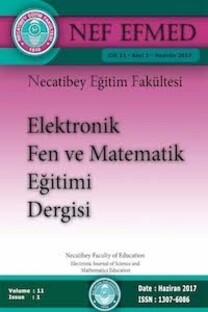5-8.Sınıf Matematik Öğretim Programının İstatistik Okuryazarlığı Bağlamında İncelenmesi
5-8. sınıf matematik öğretim programı, istatistik okuryazarlığı, veri işleme öğrenme alanı, istatistik okuryazarlığı göstergeleri
Examining the 5-8th Grade Mathematics Curriculum in terms of Statistical Literacy
5-8th grade mathematics curriculum, statistical literacy, statistics, aspects of statistical literacy,
___
- Bargagliotti, A. E. (2012). How well the NSF do funded elementary mathematics curricula align with the GAISE report recommendations? Journal of Statistics Education, 20(3), 1-26. Retrieved from tarihinde http://www.amstat.org/publications/jse/v20n3/bargagliotti.pdf 27 October 2014.
- Ben-Zvi, D., & Makar, K. (2016). International perspectives on the teaching and learning of statistics. In D. Ben-Zvi, & Makar, K. (Eds.) The teaching and learning of statistic (pp. 1-10). New York: Springer.
- Chick, H. L. ve Pierce, R. (2012). Teaching for statistical literacy: Utilising affordances in real-world data. International Journal of Science and Mathematics Education, 10(2), 339-362.
- Franklin, C., Kader, G., Mewborn, D. S., Moreno, J., Peck, R., Perry, M., & Scheaffer, R. (2005). Guidelines for assessment and instruction in statistics education (GAISE) report: A pre-K-12 curriculum framework. Alexandria, VA: American Statistical Association. Online: amstat.org/education/gaise/
- Gal, I. (2002). Adults' statistical literacy: Meanings, components, responsibilities. International Statistical Review, 70(1), 1-51.
- Gal, I., & Garfield, J. (1997). Curricular goals and assessment challenges in statistics education. In I. Gal, and J. B. Garfield (Eds.), The assessment challenge in statistics education (pp. 1-13). The Netherlands: International Statistical Institute/IOS Press.
- Hafiyusholeh, M., Budayasa, K., & Siswono, T. Y. E. (2018, May). Statistical literacy: High school students in reading, interpreting and presenting data. Paper presented at the Journal of Physics: Conference Series (JPCS), Lund, Sweden.
- Hovermill, J., Beaudrie, B., & Boschmans, B. (2014). Statistical literacy requirements for teachers. K. Makar, B. de Sousa, & R. Gould (Ed.), Sustainability in statistics education: Proceedings of the Ninth International Conference on Teaching Statistics (ICOTS9), July, 2014). Flagstaff, Arizona: USA.
- MEB. (2013). Ortaokul Matematik Dersi (5, 6, 7 ve 8. sınıflar) Öğretim Programı. https://ttkb.meb.gov.tr.
- MEB. (2018). Matematik Dersi Öğretim Programı (İlkokul ve ortaokul 1, 2, 3, 4, 5, 6, 7 ve 8. sınıflar). http://mufredat.meb.gov.tr/.
- National Council of Teachers of Mathematics [NCTM]. (2000). Principles and standards for school mathematics. Reston, Va.
- Newton, J., Dietiker, L., & Horvath, A. (2011). Statistics education in the United States: Statistical reasoning and the statistical process. In C. Batanero, G. Burrill, & C. Reading (Eds.), Teaching statistics in school mathematics- Challenges for teaching and teacher education (s. 5-8). 18. ICMI / IASE Çalışması.
- Özmen, Z. M. (2015). Farklı lisans programlarında okuyan öğrencilerin istatistik okuryazarlığının incelenmesi (Yayımlanmamış doktora tezi). Karadeniz Teknik Üniversitesi, Trabzon, Türkiye.
- Ramirez, C., Schau, C., & Emmioğlu, E. (2012). The importance of attitudes in statistics education. Statistics Education Research Journal, 11(2), 57-71.
- Rumsey, D. J. (2002). Statistical literacy as a goal for introductory statistics courses. Journal of Statistics Education, 10(3). Retrieved from http://www.amstat.org/publications/jse/v10n3/rumsey2.html 10 January 2011.
- Wallman, K. K. (1993). Enhancing statistical literacy: Enriching our society. Journal of the American Statistical Association, 88, 1-8.
- Watson, J. M. (2006). Statistical literacy at school: Growth and goals. New Jersey: Lawrence Erlbaum Associates.
- Zapata-Cardona, L., & Rocha-Salamanca, P. (2016). Teachers’ questions in the statistics class. In D. Ben-Zvi, & Makar, K. (Eds.) The teaching and learning of statistic (pp. 271-278). New York: Springer.
- ISSN: 1307-6086
- Yayın Aralığı: Yılda 2 Sayı
- Başlangıç: 2007
- Yayıncı: Balıkesir Üniv. Necatibey Eğitim Fak.
Dursun ÇAVDAR, Hasan Hüseyin ŞAHAN
Okul Öncesi Fen Eğitiminde Eleştirel Düşünme Becerileri ve Öğretmen Eğitimine Yönelik Öneriler
Deniz SARIBAŞ, Zeynep Gonca AKDEMİR, Ganime AYDIN, HASAN ÖZCAN
Okul Öncesi Örüntü Becerileri Testinin Geliştirilmesi: Geçerlik ve Güvenirlik Çalışması
Yıldız GÜVEN, Esin DİBEK, Dilan BAYINDIR, Mesut SAÇKES
İlkokul Matematik Dersi Güncel Öğretim Programının Okul Matematiği Prensiplerine Göre İncelenmesi
Kimyasal Gösterimlerin Genel Kimya Ders Kitaplarinda Kullanımı
Betül DEMİRDÖĞEN, Gülşah DEMİRCAN
A Case Study of the Length Conceptions of Fifth Grade Students
Dilşad GÜVEN AKDENİZ, Ziya ARGÜN
Fen Bilgisi Öğretmen Adaylarının Hidroelektrik Santraller İle İlgili Görüşleri
ABDULLAH AYDIN, Yıldızay AYYILDIZ, Canan NAKİBOĞLU
Development of Preschoolers’ Mathematical Patterning Skills Test: Validity and Reliability Study
